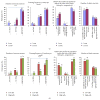Process evaluation of workplace interventions with physical exercise to reduce musculoskeletal disorders
- PMID: 25574172
- PMCID: PMC4276703
- DOI: 10.1155/2014/761363
Process evaluation of workplace interventions with physical exercise to reduce musculoskeletal disorders
Abstract
Process evaluation is important to explain success or failure of workplace interventions. This study performs a summative process evaluation of workplace interventions with physical exercise. As part of a randomized controlled trial 132 office workers with neck and shoulder pain were to participate in 10 weeks of elastic resistance training five times a week at the workplace; the 2 min group performed a single set of lateral raise to failure, and the 12 min group performed 5-6 sets with 8-12 repetitions. Participants received a single instructional session together with a training diary and manual at baseline (100% dose delivered and 100% dose received), and 59 and 57 participants, respectively, replied to the process evaluation questionnaire at 10-week follow-up. Results showed that in the 2 and 12 min groups, respectively, 82% and 81% of the participants completed more than 30 training sessions. However, two-thirds of the participants would have preferred more than a single exercise to vary between. In the 12 versus 2 min group more participants experienced the training sessions as too long (30% versus 5%). Most participants (67-92%) found the training diary and manual helpful, adequacy in a single instructional session, and satisfaction with the type of training. Among those with low adherence, lack of time (51%) and difficulties in starting exercising after illness (26%) were common barriers for regular training. Among those with low adherence, 52% felt that five training sessions per week were too much, and 29% would rather have trained a completely different kind of exercise. In conclusion, resistance training at the workplace is generally well received among office workers with neck-shoulder pain, but a one-size-fits-all approach is not feasible for all employees.
Figures





Similar articles
-
Erratum.Mult Scler. 2016 Oct;22(12):NP9-NP11. doi: 10.1177/1352458515585718. Epub 2015 Jun 3. Mult Scler. 2016. PMID: 26041800
-
Effect of workplace- versus home-based physical exercise on musculoskeletal pain among healthcare workers: a cluster randomized controlled trial.Scand J Work Environ Health. 2015 Mar;41(2):153-63. doi: 10.5271/sjweh.3479. Epub 2015 Jan 18. Scand J Work Environ Health. 2015. PMID: 25596848 Clinical Trial.
-
Clinically Relevant Decreases in Neck/Shoulder Pain Among Office Workers Are Associated With Strength Training Adherence and Exercise Compliance: Explorative Analyses From a Randomized Controlled Trial.Phys Ther. 2023 Feb 1;103(2):pzac166. doi: 10.1093/ptj/pzac166. Phys Ther. 2023. PMID: 37104630 Clinical Trial.
-
Effect of Individually Tailored Biopsychosocial Workplace Interventions on Chronic Musculoskeletal Pain and Stress Among Laboratory Technicians: Randomized Controlled Trial.Pain Physician. 2015 Sep-Oct;18(5):459-71. Pain Physician. 2015. PMID: 26431123 Clinical Trial.
-
The effectiveness of a neck and shoulder stretching exercise program among office workers with neck pain: a randomized controlled trial.Clin Rehabil. 2016 Jan;30(1):64-72. doi: 10.1177/0269215515575747. Epub 2015 Mar 16. Clin Rehabil. 2016. PMID: 25780258 Clinical Trial.
Cited by
-
Increased shoulder pain across an exercise session and subsequent shoulder exercise: a prospective cohort study.BMC Musculoskelet Disord. 2022 Jul 29;23(1):726. doi: 10.1186/s12891-022-05674-2. BMC Musculoskelet Disord. 2022. PMID: 35906579 Free PMC article. Clinical Trial.
-
How much do we know about the effectiveness of warm-up intervention on work related musculoskeletal disorders, physical and psychosocial functions: protocol for a systematic review.BMJ Open. 2020 Nov 26;10(11):e039063. doi: 10.1136/bmjopen-2020-039063. BMJ Open. 2020. PMID: 33243796 Free PMC article.
-
Intelligent Physical Exercise Training (IPET) in the offshore wind industry: a feasibility study with an adjusted conceptual model.Pilot Feasibility Stud. 2022 Jul 23;8(1):152. doi: 10.1186/s40814-022-01106-z. Pilot Feasibility Stud. 2022. PMID: 35870979 Free PMC article.
-
Reducing Physical Risk Factors in Construction Work Through a Participatory Intervention: Protocol for a Mixed-Methods Process Evaluation.JMIR Res Protoc. 2016 May 26;5(2):e89. doi: 10.2196/resprot.5648. JMIR Res Protoc. 2016. PMID: 27230696 Free PMC article.
-
Attention to Progression Principles and Variables of Exercise Prescription in Workplace-Related Resistance Training Interventions: A Systematic Review of Controlled Trials.Front Public Health. 2022 Mar 25;10:832523. doi: 10.3389/fpubh.2022.832523. eCollection 2022. Front Public Health. 2022. PMID: 35400069 Free PMC article.
References
-
- Bevan S., Quadrello T., McGee R., Mahdon M., Vovrovsky A., Barham L. Fit for Work—Musculoskeletal Disorders in the European Workforce. The Work Foundation; 2009.
LinkOut - more resources
Full Text Sources
Other Literature Sources
Research Materials

